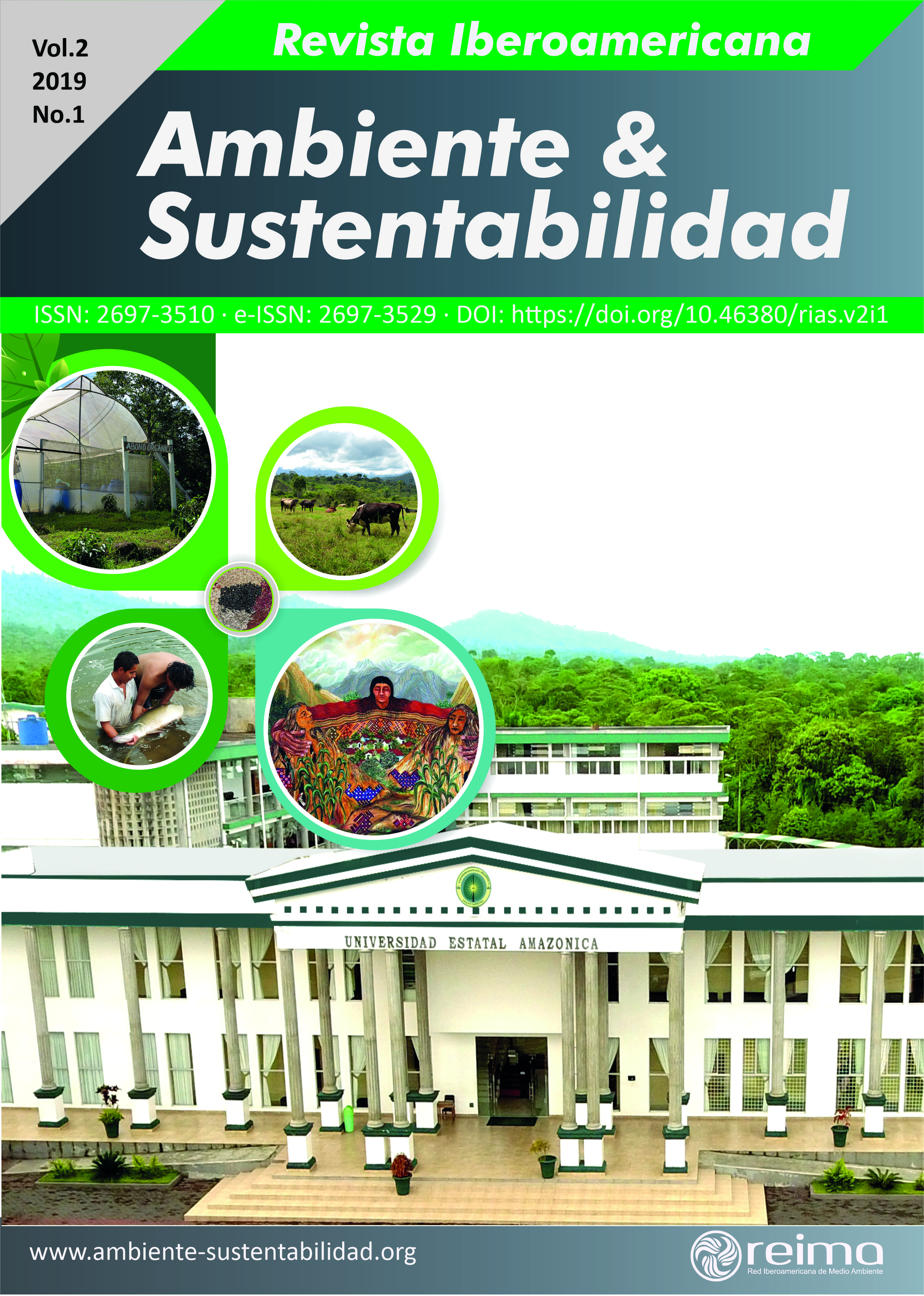Variation of some physiological indicators and performance components with organic fertilization in the variety of crystalline sugarcane in the conditions of the Ecuadorian Amazon.
DOI:
https://doi.org/10.46380/rias.v2i1.34Keywords:
organic fertilizers, sugar caneAbstract
The objective of the study was to analyze the variation of some physiological indicators and performance components with organic fertilization in the variety of crystalline sugarcane in the ecuadorian Amazon. The research was carried out on the San Carlos farm, located in the Oswaldo Hurtado compound on the Puyo-Macas road, km 29, belonging to the Simón Bolívar parish in the Pastaza canton, Pastaza province, and consisted of studying the behavior of the Cristalina variety known as Lima striped before the application of two organic fertilizers, Pollinaza and Bagazo plus a control where no fertilization was made. A randomized complete block design with three replicates was used, and variables such as tillering, number of stems per seedling, height and diameter of stems, leaf area and leaf area index were evaluated; The agricultural yield in megagrams per hectare was also calculated. The results were processed by means of an analysis of variance and Tuckey's test to determine the differences between the means for the significance level of 95% (P <0.05). It was shown that the main morphological, physiological and productive indicators of the Cristalina cane variety were superior from the organic fertilization with Pollinaza, with values ??of 15 stems per seedling, 160 cm in height 270 days after sprouting, 17.6 m2 of leaf area, with a leaf area index of 5.9 and an agricultural yield of 145 Mg ha-1.
Downloads
Metrics
References
Asociación de Cañicultores de Pastaza. (2012). Fortalecimiento del circuito del buen alimento mediante el fomento productivo, agroindustrialización y acopio en la cadena de la caña de azúcar de la provincia de Pastaza. Instituto Nacional de Economía y Solidaria. Puyo: s/e.
Buenaño, D. (2009). Influencia del método de plantación en el crecimiento inicial de la caña de azúcar (Sacharumspp.) cultivar limeña en suelos del orden inceptisoles de Pastaza [Tesis de grado, Universidad Estatal Amazónica]. http://repositorio.uea.edu.ec/xmlui/handle/123456789/46
Cheesman, O. (2004). Environmental impacts of sugar production: the cultivation and processing of sugarcane and sugar beet. Wallingford
González, R.M., Almeida, R., Jorge, H. (2004). Principales variedades de caña de azúcar empleadas en Cuba con fines comerciales en los últimos 40 años. 40 Aniversario de la creación del INICA: CD ISBN-959-246-122-8. 2004.
Martín, J.R., Gálvez, R., de Armas, R., Espinoza, R. y Viera, A. (1987). La Caña de Azúcar en Cuba. Editorial Científico-Técnica.
Masera, O., Rodríguez-Martínez, N., Lazcano-Martínez, I., Horta-Nogueira, L. A., Macedo, I. C., Trindade, S. C., ... & Müller-Langer, F. (Coord.) (2006). Potenciales y Viabilidad del uso del Bioetanol y Biodiesel Para el Transporte en México. Secretaría de Energía. https://n9.cl/zqyp
Medina, M., Giménez, D., Fatecha, A. y Adolfo G. (2011). Efecto de la fertilización mineral, orgánica y órgano-mineral en la producción de caña de azúcar de segundo año. Investigaciones Agrarias, 13(1), 1-8. https://cutt.ly/YyTzxEY
Patiño, A. (2011). Evaluación del rendimiento agroproductivo e industrial de tres variedades certificadas de caña de azúcar (saccharum officinarum) de origen cubano (c 1051-73, c 8751, c 132-81), frente al testigo variedad Cristalina, en la etapa de cosecha, en el cantón Huamboya, provincia de Morona Santiago [Tesis de grado, Universidad Politécnica Salesiana]. https://dspace.ups.edu.ec/handle/123456789/1094
Pérez, G. (2008). Clasificación Taxonómica, características anatómicas y morfológicas de la Caña de Azúcar, Fisiología del crecimiento y desarrollo. Universidad Estatal Amazónica. [No publicado]
Rieder, N.A. (2009). Fertilización química, orgánica y órgano-mineral en la producción de caña de azúcar (Saccharum officinarum) [Tesis de grado, Universidad Nacional de Asunción]. http://www.agr.una.py/fca/index.php/tesis/catalog/book/36
Romero, E., Scandaliaris, J. y Tonatto, J. (2006). Efectos de los principales factores de manejo de la plantación en la emergencia de caña planta en Tucumán, Argentina. Revista Industrial y Agrícola de Tucumán, 83(1-2), 19-28. https://n9.cl/nnf2
Suquilanda, M. (2004). Producción Orgánica de Caña Panelera. Cooperativa de producción de panela. El Paraíso, EC. CRIC- FILERAS. p. 6 - 18
Tukaew, S., Datta, A., Shivakoti, G.P., & Jourdain, D. (2016). Production practices influenced yield and commercial cane sugar level of contract sugarcane farmers in Thailand. Sugar Tech, 18, 299–308. https://doi.org/10.1007/s12355-015-0403-0
Vázquez, E. y Torres, S. (2001). Fisiología vegetal. Editorial Félix Varela.
Veer, D.M., Kadam, B.S., Patil, K.B., Suryavanshi, M.M., y Kudtarkar, U.S. (2011). Effect of integrated nutrient management on sugarcane plant cane (preseasonal) and its succeeding ratoon and sustainability of soil health in South Maharashtra. Cooperative Sugar, 42(8), 53–60. https://www.cabdirect.org/cabdirect/abstract/20113155937
Downloads
Published
How to Cite
Issue
Section
License
Copyright (c) 2019 Reinaldo Demesio Alemán Pérez, Javier Domínguez Brito, Carlos Alfredo Bravo Medina, Edgar Rubén Iza Guanoluisa, Héctor Fernando Reyes Morán, Jorge Antonio Freile Almeida, Jorge Luis Alba Rojas, Ernesto Marino Téllez, Eberto Pablo Gutiérrez Morales

This work is licensed under a Creative Commons Attribution-NonCommercial-ShareAlike 4.0 International License.
This work is licensed under a Creative Commons Attribution-NonCommercial-ShareAlike 4.0 International License (CC BY-NC-SA 4.0)
© This license allows users to distribute, remix, adapt, and build upon the material in any medium or format, provided that attribution is granted to the creator.














